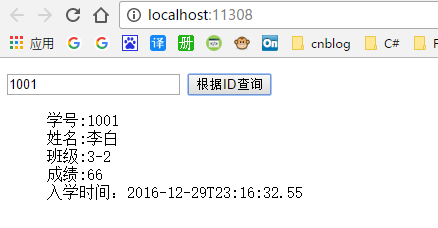分布式技术在项目中会频繁用到,以前接触过WebService(可跨平台)、WCF(功能强大,配置繁琐), 最近由于上层业务调整,将原来的MVC项目一分为三,将数据层提取出来,用API去访问。然后新建一类库项目,集成大量的辅助类来帮助MVC web端去访问Web API。
VS2013上新建WebAPI的时候会多一个区域Areas的文件夹,这个区域可以看成是一个mini的MVC项目,我向来本着技术不够,篇幅来凑的原则,来初步记录下API的基础学习,API和MVC还是有区别的,对于新手,比如我,狭隘的自认MVC主用户请求返回视图界面,API主用户请求返回数据。访问API一般分为 Jquery中的Ajax 访问、HttpClient访问,今天在这里,先写一写Ajax与Web API的那些事。
一、建Web API 项目
1、建立Web API项目之后,在Model文件夹下建立实体数据模型
2、新建一控制器StudentController,写个根据学生ID返回学生对象的方法
public class StudentController : ApiController { IBCCEntities db = new IBCCEntities(); //返回学生信息集合 public IEnumerable<Student> AllStu() { return db.Student; } //根据学生ID查询学生信息 //根据路由规则 调用: api/Student/id public Student GetStuById(int id) { Student student = db.Student.FirstOrDefault(m => m.StudentID == id); return student; } }
3. 在该项目上新建一视图,用来请求后台API数据(同项目协议、端口、域名都相同,不存在跨域问题)
<script type="text/javascript"> $(document).ready(function () { $("#btnID").click(function () { var id = $("#txtID").val(); $.getJSON("/api/Student/" + id, function (data) { var html = "<ul>"; $(data).each(function (i, data) { html += "学号:" + data.StudentID + "<br/>"+"姓名:" + data.StudentName + "<br/>"+
"班级:"+ data.StudentClass +"<br/>"+"成绩:"+data.grade+"<br/>"+"入学时间:"+data.updatetime+"<br/"; }); $("#contactID").html(html); }); }); }); </script>
只是一个最简单的Ajax调用后台,因为前台需要接收数据,所以后台Student控制器返回的学生数据对象,而不是视图

二、客户端异步调用Web API
当客户端不在服务器上, 客户端调用API是存在跨域问题的,异步调用的跨域(协议、端口号、域名)问题该怎么处理,上文演示的前台发起请求,后台API返回数据,下面来模拟客户端来调用API,另新建一MVC项目作为客户端,起始和上面前台界面相同,为了作比较,写一个ajax的底层用法
<script type="text/ecmascript"> $(function () { $("#btnID").click(function () { var id = $("#txtID").val(); $.ajax({ type: "GET", dataType: "json", url: "http://localhost:11308/api/Product/"+id, success: function (data) { var html = "<ul>"; $(data).each(function (i, item) { html += "学号:" + data.StudentID + "<br/>" + "姓名:" + data.StudentName + "<br/>" + "班级:" + data.StudentClass + "<br/>" + "成绩:" + data.grade + "<br/>" + "入学时间:" + data.updatetime + "<br/"; }); html += "</ul>"; $("#contbyId").html(html); }, error: function () { alert("發送失敗"); } }); }) }); </script>
而此时进行请求,发现浏览器会提示 加载失败,请求不被允许。

由于启动每个项目时,配置的端口号不同,所以调用API项目时,就产生的跨域,不是任何客户端都能得到服务端回执数据的,如果不在后台给客户端MVC项目的访问权限,客户端是接收不到服务端返回的数据,
处理方法:
1.在客户端添加一个类文件,用作过滤器,将客户端的URL地址写进去
public class ProductFilter:System.Web.Http.Filters.ActionFilterAttribute { private const string Origin = "Origin"; private const string AccessControlAllowOrigin = "Access-Control-Allow-Origin"; private const string originHeaderdefault = "http://localhost:20630"; public override void OnActionExecuted( HttpActionExecutedContext actionExecutedContext) { actionExecutedContext.Response.Headers.Add(AccessControlAllowOrigin, originHeaderdefault); } }
2.添加特性,把这种行为标注到一个过多个控制器或动作方法上。如:把该类文件名放置StudentController方法上
//根据学生ID查询学生信息 //根据路由规则 调用: api/Student/id [StudentFiltet] public Student GetStuById(int id) { Student student = db.Student.FirstOrDefault(m => m.StudentID == id); return student; }
目前这样虽然能达到效果,如果有多个客户端来调用此服务端的API,那岂不是需要把所有客户端的URL加到服务端,如果用一个“泛称” 添加服务端的过滤器中,这样就类似于公开接口,
如下:
private const string Origin = "Origin"; private const string AccessControlAllowOrigin = "Access-Control-Allow-Origin"; //private const string originHeaderdefault = "http://localhost:20630"; public override void OnActionExecuted(HttpActionExecutedContext actionExecutedContext) { actionExecutedContext.Response.Headers.Add(AccessControlAllowOrigin, "*"); }
用了泛称 * 代替具体的客户端好值之后,该API的接口便等于 公开接口,写的这里前台Ajax 调用API 基本如此,后面会介绍HttpClient调用API。
世人皆大笑,举手揶揄之